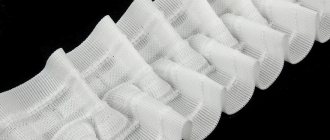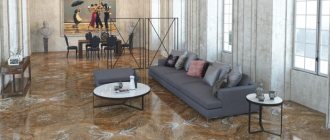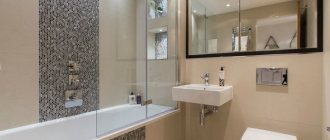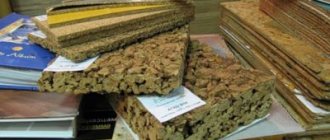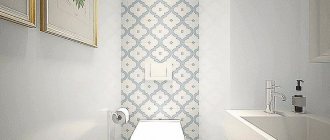No. 1. What is porcelain tile?
Porcelain stoneware is a very strong and durable type of facing covering, which can rightfully be considered a substitute for natural stone. The composition of porcelain stoneware includes such natural components as clay, mica, sand and feldspar, and a special additive in the form of granite chips gives this material special strength.
Porcelain stoneware is produced by pressing and sintering. All components are mixed together in the required proportions, pressed at a pressure of 400-500 kg/cm², and then subjected to high-temperature annealing in an oven (1200-1300°C). Using this technology, it was possible to achieve the absence of pores in the finished material and its high strength.
At first, porcelain stoneware was used as a floor covering in industrial premises with high loads; now technology has stepped far forward, which has made it possible to use porcelain stoneware not only as a floor covering in residential premises, but also for finishing walls and facades. We will look in more detail at those types of porcelain stoneware that are used specifically as flooring.
Porcelain tiles with standard thickness
As already mentioned, a thickness of 0.7-1.2 centimeters is typical for standard porcelain tiles. This type is the most popular among builders, because... its technical characteristics are optimal. With the help of such slabs, floors are covered both in residential buildings and in facilities where there is a constant flow of people, and, accordingly, a large load on the coating. The linear dimensions of the slabs can vary in the range from 5x5 to 60x60 centimeters.
The use of this facing material is described by state regulations, which contain information about the permissible load on the coating.
The standard thickness of porcelain tiles for flooring allows you to create additional types of tiles:
- technical - have the lowest cost and are used to create floor coverings in industrial workshops and warehouses. The tile received this name due to the lack of additional surface treatment. The advantage of the material is that it does not react to the influence of an aggressive environment, and the rough surface without treatment eliminates the sliding effect, increasing the safety of the work process;
- glazed - this is the most expensive type of material, which contains an additional layer of substance that allows, after firing, to give the material a different surface color. This type is most often used in residential buildings or luxury establishments, where the aesthetic beauty of the flooring is very important;
- matte - after the firing stage, the front surface of the porcelain tile is ground with a coarse-grained wheel. As a result, the tiles do not slip and look very presentable in appearance, which allows you to take a pre-sale photo of the floors in the house or show them to guests. The cost of this material is low;
- polished - externally they are the height of perfection, and in cost they exceed all other varieties. The disadvantage of a polished surface is that it cannot be used in open areas (balconies, terraces, verandas, etc.), since exposure to natural precipitation causes destructive processes on the front side;
- structured - their thickness should not be less than 1 centimeter, since a smaller value will also affect the strength characteristics of the product. Such requirements arise due to the relief of structured tiles. In places where there are depressions, its thickness will be critical, and the increased load will cause deformation. The advantage of this type is that the front surface can be an imitation of parquet, fabric, leather, etc. In special cases it is processed by etching or applying a layer of gold leaf.
The technical characteristics of this type of porcelain stoneware slabs allow them to be used anywhere. Experts believe that such material is the most reliable, effective and cost-effective.
No. 2. Advantages of porcelain stoneware
The main advantages of porcelain stoneware:
- Environmentally friendly thanks to the use of natural ingredients.
- Low water absorption coefficient . Due to the almost complete absence of pores, porcelain stoneware does not absorb water, which makes it frost-resistant. Also, the absence of pores allows you to not be afraid that the adhesive mixture will seep onto the surface of the tile and ruin it, as sometimes happens with tiles.
- Chemical resistance, be it alkali or another acid, which makes it possible to clean it with absolutely any means.
- Wear resistance and high bending strength . Porcelain stoneware is such a durable material that it has a very high bending strength per m², which makes it possible to lay it even on uneven surfaces.
- Resistance to mechanical stress . The glossy surface of porcelain tiles does not lose its shine and is scratch resistant for many years.
- Color constancy . Porcelain stoneware is absolutely not affected by ultraviolet radiation, which allows it to maintain the clarity of the pattern and the brightness of the color even with prolonged exposure to the sun.
- Anti-slip coating . There is a matte, slightly rough variety of porcelain stoneware that will remain non-slip even when wet.
- Thermal conductivity . This material does not allow cold to pass through and retains heat well.
No. 3. Types of porcelain stoneware
The following types of porcelain stoneware are most suitable for flooring:
- Technical porcelain stoneware An ideal option for covering floors in industrial premises.
- Matte porcelain stoneware This type of porcelain tile does not lend itself to any additional changes after undergoing a heat treatment cycle. This makes its surface a little rough and discreet. But it has increased hardness and anti-slip properties.
- Polished porcelain stoneware A more capricious appearance than the previous one, it has a smooth, even surface, almost mirror-like, thanks to processing with abrasives. This treatment somewhat reduces its wear resistance. For a longer service life, it must be treated with special mastics, which create an additional protective layer on its surface. Otherwise, with prolonged use, polished porcelain tiles will gradually turn matte.
- Satin. This porcelain tile has an unobtrusive light shine, which is obtained by applying mineral salts to the surface before baking in the oven. This type of treatment does not affect wear resistance.
- Structured The type of porcelain tile has a relief surface, allowing you to imitate the texture of wood (parquet porcelain tile), leather or various types of stone. Visually and to the touch it is practically no different from natural materials.
- Glazed porcelain stoneware is produced by applying a special glaze to the surface and then firing it. The glazed surface is much stronger than conventional ceramic tiles, however, this type of porcelain tile is not recommended for use in rooms with high traffic and a high level of mechanical stress. Over time, it loses its visual appeal.
- Lapped Porcelain stoneware has a mixed texture - half polished, half matte. This effect is achieved by removing a thin, uneven top layer using special polishing stones. This type can be safely used for flooring in rooms with high traffic and high loads.
- Double backfill. The top layer of the tile, approximately 3 mm, is made from the components of the required colors, and the bottom layer is made from the main components. In this way, bright, colored tiles are obtained, the wear resistance of which remains at a high level.
Errors when purchasing
- purchase of glazed, satin and other decorative types of porcelain tiles for finishing technical premises;
- finishing surfaces with relief material in areas with a high level of pollution: kitchens, crowded places, hallways, as dirt gets clogged into the reliefs and complicates cleaning;
- materials from different batches may vary slightly in shade.
Having complete information about the types and possible characteristics of porcelain stoneware, you will be able to make the right choice and buy a material suitable for a particular surface that will last a long time and will not lose its aesthetics.
No. 4. Classification of porcelain stoneware
- Size. The most popular sizes of tiles for flooring are square tiles with dimensions of 300x300 mm, 450x450 mm and 600x600 mm. If you have some kind of designer and unusual project in mind, and the floor will be the center of your interior, then you also have at your disposal tiles of the smallest size - 50x50 mm, and non-standard sizes - 200x200 mm, 150x300 mm, 300×450 mm, 300×600 mm, 400×400 mm. If you still haven't found the right size for you, you can get it using waterjet cutting .
- Caliber is the amount of permissible discrepancy in the size of the tiles, which is 3-5 mm. During the heat treatment, the edges of the tiles are slightly deformed, so they may differ from each other. To avoid large discrepancies in size, the tiles undergo a process of rectification , that is, trimming the edges using special equipment. match perfectly during subsequent installation .
- Thickness. The maximum thickness of porcelain stoneware is 30 mm, the minimum is 3 mm. With proper installation of a 3 mm thick floor covering, its strength and wear resistance are in no way inferior to a 30 mm thick covering, so there is no point in giving preference to the thickest, and therefore more expensive, porcelain stoneware. For example, recommended specifically for flooring, 8.5 mm , can withstand a load of 200 kg/cm2.
Abrasion class. Abrasion (wear resistance) is the main technical characteristic of porcelain stoneware. Depending on the degree of load and mechanical impact, there are 5 main classes of abrasion:
- PEI I, PEI II – for rooms with low traffic in soft shoes (bathroom, toilet);
- PEI III - for residential premises with an average level of traffic, without access from the street or yard (balcony, kitchen, hallway);
- PEI IV – for public spaces with high traffic levels;
- PEI V – for premises with any level of traffic and mechanical impact.
For example, for the floor covering in the entire apartment, abrasion class III is quite sufficient, and for the bathtub and toilet, class I or II can be used. If your task is to choose porcelain tiles for a private home, then choose class IV for the hallway, and for the porch give preference to class V, which is also frost-resistant. In other rooms, class III will also be sufficient.
Thickness of porcelain tiles for flooring
Porcelain stoneware also varies in thickness. Its minimum value is 3 millimeters, the maximum is 30. Material with a minimum thickness is rare. The most common parameter is 5 mm.
The best option for flooring is tiles with a thickness of 8 mm. It can withstand the loads that can occur in most rooms.
There is no direct connection between thickness and strength. If tiles 3 mm thick are installed correctly, their strength will be the same as that of 30 mm.
No. 5. Are porcelain tiles and tiles the same thing?
Many people mistakenly believe that these are really the same type of flooring, they just decided to shorten the name and raise the cost... But this is far from the case. differences significant ones at that :
- Porcelain stoneware undergoes heat treatment at significantly higher temperatures than tiles, which explains its higher strength and wear resistance .
- Due to high temperatures, the components of porcelain stoneware literally melt during processing, which completely eliminates the appearance of micropores . This prevents moisture from entering the internal structure, so porcelain stoneware can withstand high sub-zero temperatures without cracking. Tile has a porous structure and cannot withstand large temperature changes.
- Porcelain tiles are easy to clean - due to the absence of micropores, the surface becomes less dirty. A damp cleaning is enough to maintain its beautiful appearance.
- Porcelain tiles are absolutely resistant to any chemicals . This makes the cleaning process easier. Tile does not tolerate aggressive substances well and can lose its shine when exposed to, for example, alkali.
- Cracks and chips do not form on the surface of porcelain stoneware, even after a long time . Despite the fact that on tiles you can observe microcracks on the surface after just a couple of years of use.
- Porcelain tiles, due to their resistance to ultraviolet radiation , will not lose their color and clarity of design even after 50 years, which cannot be said about tiles, which fade over time.
- practically no stains . Have you noticed that when laying tiles, the adhesive mixture sometimes appears on the surface and has to be changed, since this is an irreversible process? This will never happen with porcelain stoneware due to its monolithic structure . Even if you spill a coloring substance on the surface of porcelain stoneware, it can be easily removed without leaving a trace.
- Porcelain stoneware has a high bending resistance , which allows it to be laid even on uneven surfaces. The tile breaks at the slightest distortion.
- The best porcelain tiles have absolutely smooth and clear edges, which allows you to perform seamless styling.
No. 6. Application area
Due to the variety of colors and textures and their constancy, resistance to mechanical damage and chemicals, frost resistance and bending resistance, porcelain stoneware is used for cladding walls and floors both indoors and outdoors . Due to its high levels of hardness and abrasion, this is an ideal type of coating for industrial and public spaces. It will also be used for finishing halls, swimming pools, floors in cafes and even at train stations. After all, this material is truly eternal, and the ability to produce in various sizes makes it almost universal . Whatever room comes to your mind, you can always choose the necessary type of porcelain stoneware. Porcelain tiles even replaced parquet! Both visually and to the touch it does not differ at all from natural wood.
Popular sizes
Manufacturers offer a wide range of products, among which it is difficult to choose the best option. When purchasing, remember that the larger the size and thickness of the tile, the stronger it is. Floor tiles are divided into ceramic and porcelain tiles. The first material is more affordable, but has a shorter service life. Porcelain tiles 500 x 500 are available in thicknesses up to 25 mm. This is a suitable solution for decorating floors both inside and outside the building.
The following thicknesses are considered standard for different types of materials:
- Traditional tiles – 6-11 mm;
- Tile with increased strength – up to 25 mm;
- Porcelain tiles 8–14 mm;
- Thin porcelain stoneware 4–5 mm.
Attention! This indicator is not the limit. In some cases, it is possible to increase the milk thickness to a greater value.
Pattern of tiles in different formats
The sizes of floor tiles differ from wall tiles. Moreover, if the first one looks attractive on the wall, then the second one is not suitable for the floor: it will quickly collapse, unable to withstand the loads.
Square and rectangular tiles are the most popular. For square tiles, the most common formats are edges of 150, 250 or 300 mm. If desired, you can give preference to one of them or combine several types on one floor surface. In this case, a preliminary layout must be performed.
Rectangles and squares fit into any interior, including classic ones. However, manufacturers also offer shaped and polygonal materials.
Modern floor tiles come in different sizes. This allows you to create a pattern on the floor surface that harmoniously fits into the surrounding space. Especially if you choose dimensions of 15 x 15 cm.
Dimensions of floor tiles in centimeters:
- 13 x 80;
- 15 x 15;
- 15 x 60;
- 420 x 420;
- 600 x 600;
- 1200 x 1200.
Tile thickness
This parameter belongs to the category of important characteristics; resistance to mechanical stress depends on it. The thickness of ceramic floor tiles is regulated by GOST and can be minimal:
- 8 mm if you plan to decorate an apartment or house. This 42 x 42 cm porcelain stoneware has an affordable price and normal strength. For finishing social facilities, it is better to choose tiles of the following format;
- 12 mm. Durable 20 x 60 cm porcelain tiles are suitable for any living room or office space. For areas with high traffic, it is worth purchasing thicker tiles;
- 16 mm. This is a particularly durable material that can withstand high operating loads. It is expensive, and therefore is rarely used for finishing residential premises.
Attention! The thickness of the floor tiles is not final. The height of the flooring will also increase by the thickness of the adhesive used.
The thickness of the final tile with adhesive should be optimal. The heavier the facing material, the thicker the layer will have to be formed when gluing the next element. However, excess can negatively affect the characteristics of the surface itself. The drying time of the solution will increase; over time, the laid tiles may become detached from the surface due to delamination of the material.
Decorative insert
No. 7. Disadvantages of porcelain stoneware
Despite a number of significant advantages, like any material, porcelain stoneware also has disadvantages
- Porcelain tiles are able to prevent the penetration of cold and retain heat, but this material itself is cold , just like tiles. The solution is to use heated floors.
- All types of porcelain tiles, except technical, matte and structured, will be slippery .
- Of course it is worth noting high price porcelain tiles compared to tiles. But in this case you can bet, because it’s better to spend once and get coverage with a guarantee of 50 years or morethan constantly replacing cracked or faded tiles. Moreover, there are now many types of porcelain tiles available from different manufacturers with different pricing policies. The highest price is for Italian porcelain stoneware, but there are also Belarusian, Turkish, Greek and Baltic ones, which allows you to select the material with the best price-quality ratio.
What is the difference between porcelain tiles and ceramic tiles?
The composition of ceramic tiles and granite is the same: clay, quartz sand, kaolin and feldspar. The difference lies in the production of the material. Porcelain stoneware is fired at a very high temperature, about 1300 degrees, and with a press pressure of 450 kg.
The ingredients in granite are not only sintered, but also melted, and due to the pressure of the press, it prevents the formation of micropores, which cannot be said about ceramic tiles. This property increases the service life of the material outdoors, as well as the external walls of buildings. Porcelain stoneware steps last a long time and do not require renovation or repair, because they do not allow moisture to pass through and can withstand extremely high or low temperatures.
To decorate apartments, offices, and salons, you do not need expensive porcelain tiles; it is enough to lay tiles inside the room. But people prefer granite tiles due to its numerous benefits.
I must say that it is better not to put porcelain stoneware in rooms, because it, like tiles, is cold. To eliminate this, it is recommended to make a heated floor, but this is too complicated and expensive.
Usually it is placed in the kitchen, hallway, bath, toilet and other similar rooms. For high-traffic areas, anti-slip porcelain tiles are used for the floor to avoid unnecessary injury.
How to lay tiles on the floor yourself? Video:
No. 8. What should you pay attention to when purchasing?
- Before purchasing, you need to already know what size tiles you want . This way you can easily figure out their quantity by dividing the desired coverage area by the area of one tile.
- Please note that all tiles match in color and shade . All tiles must be from the same batch, otherwise the difference in shade will be very noticeable after installation!
- The caliber of all tiles should also be the same - this will ensure a beautiful, uniform installation without visible differences in size.
- Be sure to check the weight ! The recommended tiles for flooring are 8-8.5 mm thick and weigh at least 18.5 kg. Do not hesitate to clarify this point, otherwise you risk buying a fake!
- The back side of the tile can also say a lot. It should have shallow, small squares with sides of a maximum of 2x2 cm. The larger and deeper these technical notches are, the lower the quality of the material.
- Do not forget about the reserve , which should be 10% of the total number of tiles for the diagonal laying method and 5% for other methods.
- The packaging of porcelain tiles for flooring will show foot on a black background, if this sign is repeated, it means a higher wear resistance class. If you see snowflake - This is a frost-resistant porcelain stoneware.
No. 9. Features of laying porcelain stoneware
If you decide to refuse the expensive services of professionals and decide to install porcelain stoneware yourself , you should approach this issue very carefully, because the durability of the coating will depend on the correct installation.
Porcelain stoneware, as a very durable material, is very difficult to cut, so that you do not have any difficulties or surprises during the installation process, prepare all the necessary tools :
- You will definitely need a tile cutter or grinder
- Required building level
- A spatula with a smooth edge is for applying the adhesive mixture and a spatula with a serrated edge is for removing excess mortar.
- A construction bucket or other convenient container for mixing the adhesive mixture
- Drill and special construction mixer to facilitate the mixing process
- Water container
- Rubber hammer
- Plastic crosses, which regulate the width of the seam, are chosen to your taste
Since porcelain stoneware is very heavy, it is necessary to choose a mixture that will withstand heavy loads. It is better to choose a plastic adhesive mixture with high “tenacity”; in addition, it prevents the tiles from falling off if your house is not yet fully settled and “walks” when temperatures change or the foundation settles. When the adhesive mixture is selected, move on to the next step.
Surface preparation
Although porcelain stoneware provides for differences of up to 15 mm, it is better to pre-level the surface by pouring concrete, pre-waterproofing, and then carefully prime it . If porcelain tiles are laid on a heated floor, then the sequence will be as follows - waterproofing the room, laying a heated floor, pouring concrete (screed), impregnating with soil, laying porcelain tiles. By the way, installation on old wooden floors is not allowed . After preparing the surface, you can proceed to the mixture. Stir the adhesive mixture according to the instructions on the package. If you are laying tiles for the first time, you should not mix the whole mixture at once, in case you will have difficulties in the process, and the mixture does not retain its adhesive properties for so long. It’s better to start by diluting a small amount, literally a couple of tiles, and try to lay them, thereby testing your capabilities.
Characteristics of porcelain stoneware that you need to pay attention to
Strength
We mentioned this option above. On the MOHS scale, matte porcelain tile is second only to diamond, leaving marble and granite behind. Despite the varying degrees of strength, any type of artificial stone surpasses most finishing materials in this parameter.
Mohs scale. For example, ordinary sand has a hardness of 7. Therefore, when laying, you must immediately remove the remaining mixture from the surface and seams so as not to damage the coating before use. Lay a rug on the floor in the hallway that will collect all the sand from the street.
Moisture resistance
Low porosity ensures almost complete absence of water absorption - up to 0.05%. Thus, rooms and facades can be decorated based on this aspect using any type of porcelain stoneware. Thanks to the hydrobarrier, the material tolerates temperatures down to -50. Conventional ceramics, due to their absorbent structure, are quickly destroyed at subzero temperatures.
Wear resistance
Abrasion resistance is measured on the PEI scale, which is graded into five classes:
- I – wall ceramic granite;
- II – porcelain stoneware for the floor of residential premises with low traffic;
- III – slabs for medium-traffic areas (up to hundreds of people per hour);
- IV – ceramic granite for public places with traffic up to several hundred people per hour;
- V – porcelain tiles for the floors of areas with the most intense traffic (stations, airports);
The packaging, which always indicates the class of the tile, will help determine the appropriate material.
Designation of pictograms on packaging with tiles.
Format
Porcelain tiles imitating natural stone 30x30 cm Keope Ceramiche Alpi (Italy).
The size of porcelain tiles is related to the area of the room. Large tiles in a small area almost always look worse than small ones. The format is associated not only with design, but also with the durability of the cladding. Ceramic granite 600x600 mm requires a better base and higher quality adhesive than tiles measuring 30x30 cm. The golden mean is 45x45 cm; such slabs are not bad, from a design point of view, for any room. In addition, they are very convenient to install: they provide high speed and adequate response to small flaws in the base plane.
Thickness
Porcelain tiles for flooring are produced in thicknesses of 7-30 mm. The thicker, the more durable. The parameter is directly related to the degree of abrasion.
Load resistance
The maximum load that ceramic granite can withstand, according to one classification, is 2000 N. The bending strength is 45–55 MPa. For comparison: the UNI EN 14441 standard is 27 MPa. Specific indicators depend on the thickness, size of the tile and load. The video shows the strength testing of porcelain stoneware. A 30-ton truck drives over large-format slabs.
